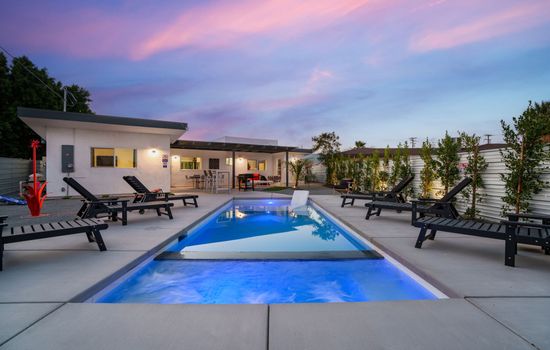The Visitor Center is open Friday, Saturday, and Sunday from 8:30 AM to 4 PM. It is scheduled to reopen to the public on October 4, 2024, after a temporary closure.
Most federally managed sites in the Santa Rosa and San Jacinto Mountains National Monument do not require fees, but some USFS-operated sites may have fees, such as the Pinyon Flat campground at $8 per night.
From Palm Desert, take Highway 74 south for 4 miles to reach this breathtaking monument, where desert landscapes meet snow-capped peaks.
Parking is available at the Visitor Center on Hwy 74, Palm Desert. No specific size restrictions mentioned for RVs or motorcycles. No overnight parking permitted. No fees specified for parking at the Visitor Center.
Accessibility & permits
Emergency
- Cell service availability:Partial
Information not accurate?
Help us improve by making a suggestion.
In the heart of Southern California, the Santa Rosa and San Jacinto Mountains National Monument rises dramatically from the desert floor, a stark contrast to the arid landscape below. This 280,071-acre haven, jointly managed by the U.S. Forest Service and the Bureau of Land Management, is a tapestry of diverse landscapes, from the snow-capped peaks of the San Jacinto Mountains to the lush palm oases that dot the terrain.
Hikers can explore the extensive backcountry via trails such as the Pacific Crest Trail, which winds through alpine forests and rugged canyons. The monument is home to two federal wilderness areas, the Santa Rosa and San Jacinto, providing pristine habitats for rare species like the Peninsular Bighorn Sheep.
Seasonal changes paint the landscape in vibrant colors; spring brings blooming wildflowers, summer offers warm days perfect for hiking, and winter transforms the mountains into a serene snow-clad retreat. The area is also rich in cultural heritage, with over 200 recorded cultural resources, including the historic Martinez Canyon Rockhouse.
Nearby, the alpine village of Idyllwild and the desert communities of Palm Springs and Palm Desert offer a mix of artisan charm and luxurious amenities. Visitors can enjoy local cuisine, artisan shops, and galleries, making this national monument a unique blend of natural beauty and cultural richness. For those seeking immersive experiences, ranger-led tours and educational programs provide deep insight into the monument’s ecological and historical significance. Whether you are a nature enthusiast, a culture aficionado, or simply a traveler seeking breathtaking vistas, the Santa Rosa and San Jacinto Mountains National Monument is a must-visit destination.
- Area (mi²)
- 439
- Annual visitors
- 45 000
- Established year
- 2000
Top 3 Facts about Santa Rosa and San Jacinto Mountains National Monument
The monument protects a unique subspecies of bighorn sheep, Ovis canadensis cremnobates, and features a natural oasis of California fan palm, the only native palm species in the state, with some palms reaching heights of up to 15 meters.
In this dramatic landscape, Peninsular bighorn sheep and desert tortoises roam amidst montane coniferous forests of Jeffrey pine, ponderosa pine, and incense cedar. Rare flora includes Hidden Lake bluecurls and Munz’s mariposa lily. Bird enthusiasts can spot white-headed woodpeckers, Steller’s jays, and golden eagles, while over 40 species of reptiles and mammals like bobcats and mule deer inhabit the area. The diverse biotic communities support a rich tapestry of life, from desert sand verbena to high mountain meadows.
Rising abruptly from the desert floor, these mountains soar to 10,834 feet, with San Jacinto Peak reaching 10,804 feet. The landscape is dotted with magnificent palm oases and snow-capped summits, offering a dramatic contrast of hot desert temperatures and cold alpine climates. The area is also home to archaeological sites of the Cahuilla Indians and features a national scenic trail that winds through extensive backcountry.
Family programs
- Junior Ranger
- Ranger-led Tours
- Self-guided Tours
- Workshops & Hands-on Activities
- Scavenger Hunts
- Night Sky & Astronomy
- Family Camping & Overnight
- Volunteer & Stewardship.
Travel Tips
Plan Ahead
Plan a few days in spring to avoid desert heat. Use Palms to Pines Highway or the Aerial Tramway. Park at the visitor center, bring water, sunscreen, and a picnic. Anticipate rocky terrain and rest often. Enjoy cooler temps and scenic hikes during the Wildflower Festival.
Pack Appropriately
Pack layers for chilly mornings and evenings, and warm afternoons. Bring hiking shoes, sandals, a light jacket, sunscreen, a sun hat, and a daypack. For camping, add a tent, sleeping bag, and portable charger. Check the season for specific gear needs.
Respect Wildlife
Maintain a safe distance from wildlife, at least 25 yards, to avoid disturbing them. Respect seasonal habitats and follow park rules to preserve the unique flora and fauna. Leave no trace, taking all trash and belongings with you upon departure.
Stay Informed
Exercise caution on trails, near ledges, and around water. Check weather conditions and park rules. For emergencies, call 911 or park authorities. Stay informed, stay safe.
Seasons
Spring brings mild temperatures (60s-80s°F) and wildflowers to this desert-mountain oasis. Join the annual Spring Bioblitz in April to explore 280+ miles of trails and document biodiversity alongside researchers. Ideal for hiking, horseback riding, and mountain biking amidst blooming landscapes.
Escape summer heat in the mountains, where temperatures drop 30-40°F from the valley. Hike 280+ miles of trails, enjoy scenic drives, and participate in the Summer BioBlitz in June and July. Bring sunscreen, water, and comfortable shoes for a unique summer adventure.
Autumn beckons with mild temperatures (60s-70s°F) and clear skies. Witness the Fall Color Festival, hike through golden landscapes, and enjoy serene wildlife viewing amidst the desert’s vibrant fall blooms. Ideal for comfortable hikes and scenic drives, fall is a prime time to visit.
Visit from late November to March for a winter wonderland. Temperatures range from 20°F to 50°F, with variable snow and icy conditions. Traction devices recommended for hiking. A unique blend of desert and snowscape awaits the adventurous traveler.
Information not accurate?
Help us improve by making a suggestion.
Where to stay
Frequently Asked Questions
Ready to dive into what Santa Rosa and San Jacinto Mountains National Monument has to offer? Let’s tackle some of the burning questions you might have as you plan your visit!
-
The closest city to the monument is Palm Desert, California. This city is located near the monument’s visitor center on Highway 74, south of State Highway 111.
-
Dogs must be on a leash no longer than 6 feet at all times in the Santa Rosa and San Jacinto Mountains National Monument. This rule applies especially on Bureau of Land Management lands to protect critical sites for Peninsular Ranges Bighorn Sheep. Certain trails are off-limits to dogs to ensure compliance with regulations.
-
Yes, there is parking available. The Visitor Center has a parking lot located at 51-500 Highway 74, Palm Desert, CA 92260. Additionally, the upper parking lot near the Randall Henderson Trailhead is open to visitors.
-
Start at the Santa Rosa and San Jacinto Mountains National Monument Visitor Center in Palm Desert to plan your day. Take a scenic drive on the Palms to Pines Scenic Byway to the mountain town of Idyllwild, and stop at Lake Hemet or Hurkey Creek Lake along the way. Use the Palm Springs Aerial Tramway to explore the San Jacinto Wilderness, or hike to Mount San Jacinto, the highest peak in the San Jacinto Mountains at 10,883 feet.








